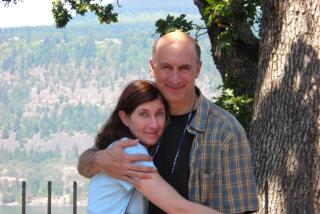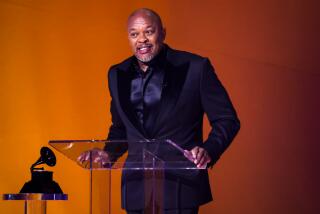Prose at the Point of a Scalpel : I WANT TO THANK MY BRAIN FOR REMEMBERING ME.<i> By Jimmy Breslin (Little, Brown: $22.95, 219 pp.)</i>
Of course Jimmy Breslin, newspaper columnist and New York chronicler, did not develop a cerebral aneurysm just so that he could write about it. It was a hijacking or a drowning, and you don’t arrange those.
Still, here is Breslin with waterproof notebook and underwater pen to record both the drowning itself--a dangerous brain operation--and the flash-by of the past that drowning is said to elicit. In the midst of death, he is in life, interviewing the one and the other with his passionate insistence on getting the quotes and the knowledge of where you go to get the best ones.
New Yorkers always need to tell you where to get the best ones of anything at all, preferably somewhere that hardly anyone knows about and that won’t be in fashion for six months yet. New York hell is eating in a four-star restaurant and hearing that five stars are being considered for an unmentioned little place up the street.
So, his left eye bulging oddly--the diagnoses are not yet in but they will soon point to the aneurysm--Breslin heads for the afflicted streets of New York City’s South Jamaica to soothe his growing panic with a preoperative dose of work. (By taxi this time, because he can’t see well enough for the usual subway.)
“I had to go into a black neighborhood, where the maimed and lame are so common that I’d be just another castaway,” he writes. “There also happens to be so much happening in one of these neighborhoods, so many shots fired, so many babies born, so many people fighting life while they go to work or beg for work, and all of this done while the people explain themselves with verbs that send sentences sliding along like loose change spilled on a polished floor.”
Verbs--and his verbs. Throughout “I Want to Thank My Brain for Remembering Me,” this is the still image between his circus of memories and the eviction threat proffered by his doctors.
There are stories of his deprived and battered Queens childhood, accounts of the pinochle-playing, hang-out-with-the-cops-and-the-wise-guys journalism of the ‘40s (quite different from letting it all hang out, which came much later). There are the brash yet expressive portraits of the city’s high-ups, low-downs and down-and-outs. Peopling his columns for more than 30 years, they made a vivid mosaic, if not exactly of the city, at least of an image that the city could recognize itself in and a lingo it could hear itself speaking.
Intercut among anecdotes and reflections, there is what elicits them. Breslin tells of his baffling early symptoms, uncertainties, terrors and denials, and the search for doctors and diagnoses. There is a taut narrative, taken subsequently from surgical notes and interviews, of the dangerous and delicate operation performed in Phoenix by Robert Spetzler, a world expert on aneurysms.
Spetzler quests through Breslin’s brain like one of Arthur’s knights pursuing the dragon at the Castle Perilous. The dragon is slain--stapled off, in this case--and Breslin emerges from the castle to write the book.
He stands in the foreground: the tough and tender journalist, knowing but also sentient, a flowery writer but also a gifted one. He dabbles among cliches and comes up with discoveries. At its best, his work has the impact of a different art: that of Daumier and Rowlandson. His account of Ronnie Eldridge, his second wife, sitting on the staircase until morning when she must tell her children of the death of their father, her first husband, suggests almost literally Rowlandson’s celebrated engraving of a condemned prisoner.
He does a lot of name-dropping. Journalists may aspire to the role of awkward truth-teller that Shakespeare assigned to his clowns and jesters. Touchstone, though, did not casually mention how much his duke esteemed him nor did the Fool boast of his standing at King Lear’s court. Breslin has caught the journalist-as-celebrity bug; some of it is justified, of course, since it is his intimacy that provides the quotes.
Those of us on managed care may not share Breslin’s satisfaction that Mario Cuomo, then governor of New York, had his health commissioner spend the better part of a day getting the name of a suitable specialist, although what follows rather makes up for it. Spetzler, by all means, the commissioner reported, particularly for unusual aneurysms. “I think Breslin feels it is an unusual aneurysm,” Cuomo replied. “It’s in his brain.”
It is worth the name-dropping--of a different kind--to meet such Breslin sources as Fat Thomas, the 400-pound bartender at a mob hangout in Queens, and Marvin the Torch, who advertised his pyromaniacal skills with the words, “I build empty lots.” Breslin is a celebrity arbitrageur. Fat Thomas got a charge out of knowing that his columnist friend knew the big political and society figures; they got a charge out of knowing he knew the likes of Fat Thomas.
The book diligently follows the rules of the New York Music Manual: No matter how sweet you play the trumpet (Breslin is very sweet), never omit to blow your own horn at the same time. Describing his column--a same-day vignette of low-down or higher-up New York told in the participants’ words and suggesting something about the city’s life--Breslin says that he invented the form. “Other papers,” he writes, “immediately went out and hired imitators with Irish names.”
More dubiously, he claims to have devised the art of covering a big story by going somewhere the rest of the pack hadn’t thought of. His interview with an Arlington Cemetery gravedigger on the day of John F. Kennedy’s funeral is still taught in journalism schools, he writes. Editors, he writes, are still telling young reporters: “Go find the gravedigger.”
Have Statue Will Travel. It can be wearing. Yet the anecdotes, along with some trenchant reflections, redeem a good deal of the brag. So does a darker strain. Call it Have Statue Will Travel--For a While. Breslin intimates his mortality--not because the operation may kill him but because it may kill his memory and language or, as he puts it, his verbs. They are his bottle of salvation. Nobody, not even Spetzler, can assure him that it will not shatter.
“I knew that if something happened to the curl in my brain that causes verbs, I would be one of those home relief cases that people hate so much. . . . I sure didn’t want to start thinking about not being able to write a verb: rush, race, run, gallop, canter, veer, saunter. What if they all came out as bus?”
We begin to see that the book is more than a memoir told in counterpoint to a present-day ordeal. It is a testing of recovery. Like a runner who does extra laps after breaking a leg, Breslin puts on a bravura display of the anecdotal memory that is at the heart of his reporting. His writing races, veers and saunters, down-shifting and cornering at every rise and curve. It is frenetic, entertaining and moving, although now and then something plainer and slower would be welcome--perhaps even a bus.
More to Read
Sign up for our Book Club newsletter
Get the latest news, events and more from the Los Angeles Times Book Club, and help us get L.A. reading and talking.
You may occasionally receive promotional content from the Los Angeles Times.







